
Large flying boats
from Short Brothers
In addition to the Sunderland,
Short Brothers produced a range of aircraft, often converted from the Sunderland
or derived from its designs. Below is a brief list (inlcuding the Short
Brothers type numbers) which will attempt to make the many variations clear.
|
Empire Flying Boat |
|
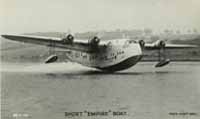 |
C-Class (Type Numbers:
S23 + S30 + S33) Civil, 40 built,. First flight 3 July 1936 Built to the order of Imperial Airways, the civilian Empire Flying Boat provided airmail and also luxury passenger service linking Britain to its colonies in India and Africa from 1937. Two variations were produced in addition to the original specification: Type S30 was a longer range version while the S33 had a strengthened hull |
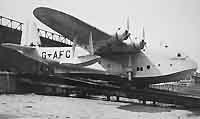 |
G Class (S26)
Civil, Three built, First flight 21 July 1939 The G-Class boats were basically a scaled up version of the Empire Boats planned for use on transatlantic routes. Launched in 1939 they were drafted into the war effort instead. |
| Short Sunderland | |
|
|
MkI, MkII, MkIII and MkV S25 Military, 749 Built,. First flight October 1937 Ordered by the RAF in 1933, it was designed in parallel to the Empire Boats and, despite looking similar, shared little in the structure. Mk I and II easily distinguished by twin gun hatches in the upper hull behind the wing, while the MK III had a mid upper turret. the MKV adopted the Pratt and Whitney engine in place of the Bristol Pegasus and removal of the turret. A total of 88 early aircraft were converted to MKV. |
| Short Hythe | |
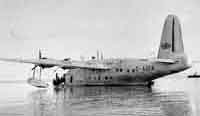 |
Civil, 23 converted, First flight 26 December
1942 Conversion of the Short Sunderland for BOAC with austerity benches initially named after BOAC Hythe flying boat base. The gun turrents were simply covered over. They also operated with RAF transport command under military markings and continued in use postwar, gradually replaced by Sandringhams. |
|
Short
Sandringham
|
|
|
|
Civil, 29 converted, First flight 28 Novmber
1945 Conversion of the Sunderland by Short Brothers with replacement nose and tail and extensive rebuilding to create a passenger cabin. One of the Short Hythes was first to undergo the conversion to create the Sandringham's more streamlined hull. Aircraft were supplied to BOAC and to overseas airlines in South America, Australasia and Norway. Postwar Aquila Airlines operated them to Lisbon and Madeira. |
| Civil Sunderland | |
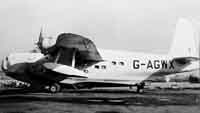
| Civil, At least eight converted. Not an official category but some Sunderlands were converted for passenger carrying by Shorts postwar without the new nose and tail of the Sandringham. They kept the name Sunderland, although used for passengers. One aircraft was similarly converted by TEAL in Australia and today is in Florida - the only potentially airworthy Sunderland: N814ML. |
| Short Seaford | |
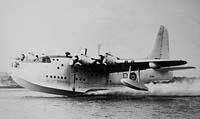
| S45 (ex Sunderland IV) Military, Two Mk IV and eight Seafords built, First flight 30 August 1944. Originally designated MK IV Sunderland, the aircraft had a larger fuselage and more powerful engines but, with no performance improvement over the MkV Sunderland, the type was briefly evaluated by Transport Command before most were delivered back to Short Brothers for conversion to passenger carrying and designated Solents. |
| Short Solent | |
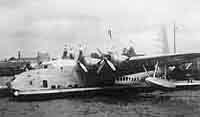
| Civil, 7 converted from Seaford/MkIV, 16 new
build. Initially built for BOAC, the Solent was a passenger aircraft based on the hull design for the MkIV Sunderland and made use of the jigs and tooling which would otherwise have lain idle. Used by BOAC and later Aquila Airways and TEAL. |
| Short Shetland | |
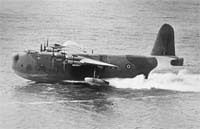
| S35 +S40 Civil Military and Civil, Two prototypes built. First flight 14 December 1944 The planned replacement for the Sunderland, the two Shetland prototypes were built to show military and civil use but neither went into production. The military version (DX166) was destroyed at her mooring by fire and the civil boat (G-AGVD) was eventually scrapped at Belfast. |
| Short Mayo Composite | |
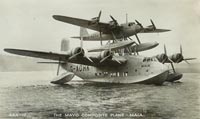
| S20 + S 21 Civil, One pair built, Flight trials Jan/Feb 1938. A unique experiment to create an aircraft capable of carrying airmail across the Atlantic. The smaller aircraft (Mercury) when loaded with mail and enough fuel for the crossing could not take off. But she could fly at that weight so the simple proposal was to use a larger aircraft, Maia, (basically a modified Empire Boat) as a mother ship to lift her into the air. She operated to N America and South Africa during 1938 and set a seaplane distance record. |